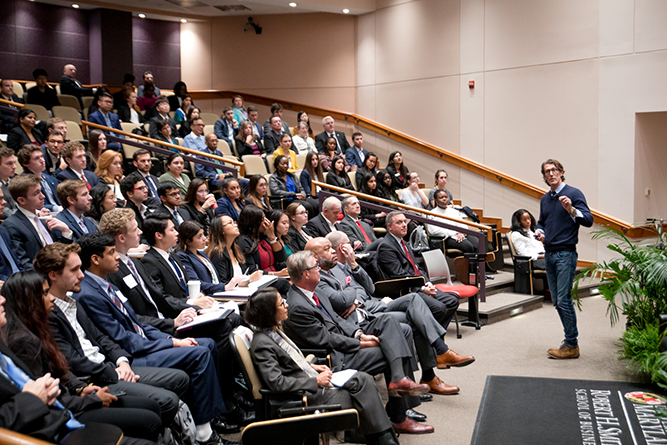
Mattel President and COO Richard Dickson answers a tough question: How do brands stay relevant?
Speaking to an audience of students, faculty, staff and guests at the University of Maryland’s Robert H. Smith School of Business, Dickson ’90 told the story of Mattel, described how he finds inspiration, broke down the reinvention of a legacy brand and offered some good, old-fashioned career advice. Dickson was on campus this week for the fall 2019 installment of the CEO@Smith speaker series, a conversation moderated by Maryland Smith interim dean Ritu Agarwal.
On continuing a legacy: The average lifespan of a big company is 18 years. Mattel will celebrate its 75th anniversary next year. When Dickson took over as President and COO in 2014, he had the task of making dozens of iconic toy brands relevant to today’s kids, while still staying true to their heritage.
“When you inherit brands with legacy, the first thing that you have to do is go back to the very beginning. What made them great to begin with? What were our founders thinking?” asked Dickson.
Dickson proudly displays in his office a photo of the Southern California garage where Mattel was founded. He tries to decorate as many Mattel offices as he can with the image.
“I make sure that everybody connects to what that garage represented: the entrepreneurial spirit, that ability to take risks, that ability to look at culture around you and bring insights into action,” Dickson said.
He told the story of the iconic Barbie brand.
“Barbie has been through it all - the rise of the Berlin Wall, the Beatles, the computer, hip-hop, space travel. She has stood the test of time,” said Dickson.
Today, Mattel sells 100 Barbies per minute. How did Mattel get here? A blend of art and science, said Dickson.
“Design, retail experiences, franchise management – these are all part of the creative process. But it won't be successful without the other side, which is the science – the data, the insights, the analytical tools, the supply chain optimization, the speed-to-market.”
On purpose-driven innovation: Nearly two-thirds of millennials and generation Z prefer brands that have a point of view and choose to stand for something. Dickson explained how he’s driven some of Mattel’s famous brands, like Barbie, in a purpose-driven direction.
“If you as marketers, or anybody in the company, and don't think about how you can market your product with some form of purpose, you're missing a big consumer insight,” he said.
A few years ago, Dickson took a critical look at the Barbie brand. He wondered how Barbie could be a role model in today’s society. The doll had been in three years of decline. Dickson called it a “wake up call.”
Mattel shifted the conversation around Barbie from a monologue to a dialogue.. “Once we started to have that dialogue with our consumers, what we realized was, ‘We've got to change the face of the doll,’” said Dickson. “That’s exactly what we did, to be a better reflection of what girls see in the world.”
Mattel created a new line of Barbies with dozens of different looks including different ethnicities, body shapes and dolls with wheelchairs.
On defining success: To the Maryland Smith students in the audience, Dickson suggested allowing their definition of success to grow and change over time. To Dickson, success today means happiness. “I come to what I do every day with my heart and my mind united, and it's purposeful,” said Dickson. “I find all the challenges that I have to overcome not necessarily a negative part of my day.”
“You may not love every part of what you do, he said, but if you don’t like the majority of it, you’re not doing the right thing,” he shared.
Dickson offered some advice for entry-level employees trying to prove themselves.
“You’ve got to be dedicated and you’ve got to be willing to put in your time,” he said.
“You're not always going to like what you're doing, and that's fine. But it's really important that you put in the time and you build your work ethic. You may not realize it, but the people who are above you are taking notice. It absolutely shows and gets you above the radar.”
He adds, “I would encourage you to find what you love as fast as you can. We don't have a lot of time here.”
— Kira Barrett, Communications Writer at the University of Maryland’s Robert H. Smith School of Business
Media Contact
Greg Muraski
Media Relations Manager
301-405-5283
301-892-0973 Mobile
gmuraski@umd.edu
About the University of Maryland's Robert H. Smith School of Business
The Robert H. Smith School of Business is an internationally recognized leader in management education and research. One of 12 colleges and schools at the University of Maryland, College Park, the Smith School offers undergraduate, full-time and flex MBA, executive MBA, online MBA, business master’s, PhD and executive education programs, as well as outreach services to the corporate community. The school offers its degree, custom and certification programs in learning locations in North America and Asia.